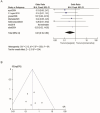Pituitary apoplexy: surgical or conservative? A meta-analytical insight
- PMID: 40535550
- PMCID: PMC12174462
- DOI: 10.3389/fsurg.2025.1579498
Pituitary apoplexy: surgical or conservative? A meta-analytical insight
Abstract
Objectives: The challenge in treating pituitary apoplexy lies in choosing between conservative management and surgical intervention, with a current lack of high-level medical evidence to guide the selection of treatment options. This study compares the recovery rates of typical clinical manifestations following surgical and conservative treatments, aiming to provide evidence-based medical support for clinical treatment decisions.
Methods: Relevant literature published between 1991 and 2024 was searched using PubMed, Embase, Cochrane Libraries, and CNKI. After a rigorous screening process to apply the inclusion and exclusion criteria, the primary clinical observation indicators were carefully extracted. The recovery rates of the main clinical observation indicators were evaluated using Reman v5.3. A fixed-effects model was employed to determine the merged odds ratio (OR) values, utilizing the Mantel-Haenszel estimation method. Publication bias was assessed using a funnel plot. Heterogeneity between studies was analyzed with the Cochran Q (Chi-square) test and I² statistics.
Results: The meta-analysis results indicated that surgical treatment significantly improved recovery from ocular muscle paralysis compared to conservative treatment (OR: 0.31; 95% CI 0.10-0.92; p = 0.04). However, no statistically significant differences were observed in postoperative recovery of visual acuity (OR: 1.15; 95% CI 0.54-2.44; p = 0.72), visual field recovery (OR: 1.48; 95% CI 0.77-2.82; p = 0.24), or pituitary endocrine function (OR: 0.67; 95% CI 0.27-1.67; p = 0.38).
Conclusion: Our research findings suggest that patients with pituitary apoplexy presenting with ocular palsy may benefit more from surgical treatment.
Keywords: conservative treatment; meta-analysis; pituitary apoplexy; surgical treatment; systematic review.
© 2025 Xia, Peng, Zhou, Liu, Chen, Xu, Wang, Deng, Tang and Hu.
Conflict of interest statement
The authors declare that the research was conducted in the absence of any commercial or financial relationships that could be construed as a potential conflict of interest.
Figures





Similar articles
-
Surgical versus non-surgical treatment for pituitary apoplexy: A systematic review and meta-analysis.J Neurol Sci. 2016 Nov 15;370:258-262. doi: 10.1016/j.jns.2016.09.047. Epub 2016 Sep 23. J Neurol Sci. 2016. PMID: 27772771
-
Risk factors on length of stay among pulmonary tuberculosis patients: A systematic review and meta-analysis.Int J Nurs Stud Adv. 2025 Mar 6;8:100316. doi: 10.1016/j.ijnsa.2025.100316. eCollection 2025 Jun. Int J Nurs Stud Adv. 2025. PMID: 40535787 Free PMC article.
-
Efficacy and safety of combining re-irradiation with bevacizumab compared to bevacizumab alone in the management of recurrent high-grade gliomas: a meta-analysis and systematic review.Ther Adv Neurol Disord. 2025 Jun 14;18:17562864251343574. doi: 10.1177/17562864251343574. eCollection 2025. Ther Adv Neurol Disord. 2025. PMID: 40529988 Free PMC article.
-
Prevalence and odds of anxiety and depression in cutaneous malignant melanoma: a proportional meta-analysis and regression.Br J Dermatol. 2024 Jun 20;191(1):24-35. doi: 10.1093/bjd/ljae011. Br J Dermatol. 2024. PMID: 38197404
-
Prenatal administration of progestogens for preventing spontaneous preterm birth in women with a multiple pregnancy.Cochrane Database Syst Rev. 2019 Nov 20;2019(11):CD012024. doi: 10.1002/14651858.CD012024.pub3. Cochrane Database Syst Rev. 2019. PMID: 31745984 Free PMC article.
References
Publication types
LinkOut - more resources
Full Text Sources

